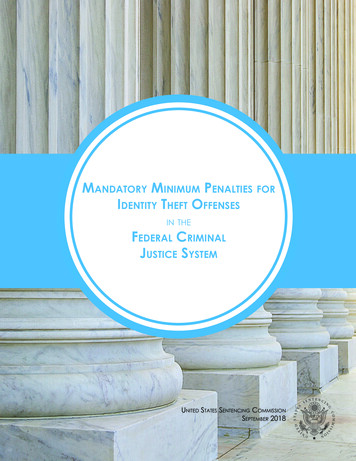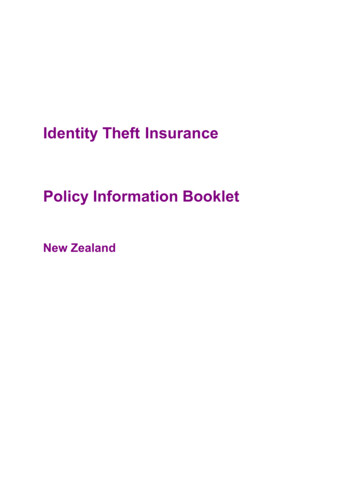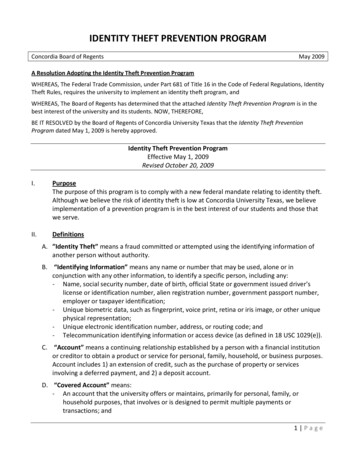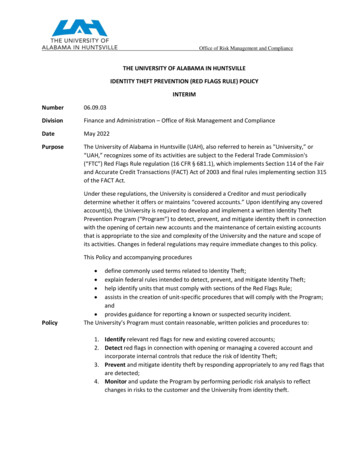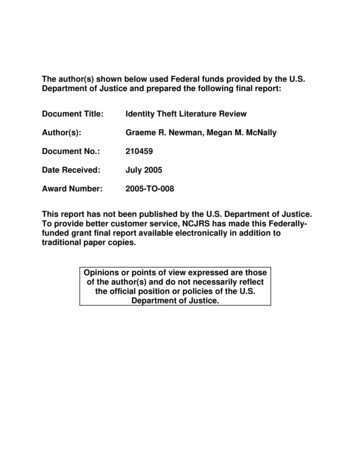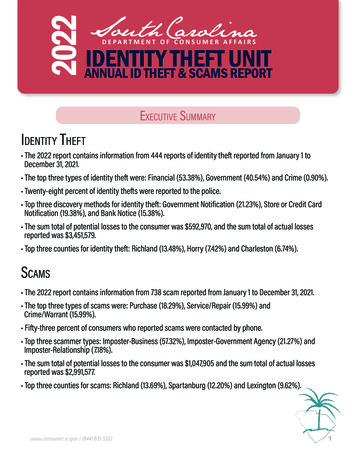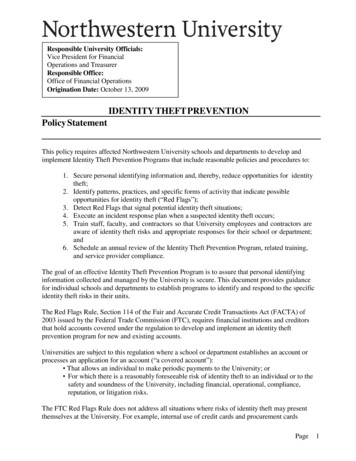
Transcription
Responsible University Officials:Vice President for FinancialOperations and TreasurerResponsible Office:Office of Financial OperationsOrigination Date: October 13, 2009IDENTITY THEFT PREVENTIONPolicy StatementThis policy requires affected Northwestern University schools and departments to develop andimplement Identity Theft Prevention Programs that include reasonable policies and procedures to:1. Secure personal identifying information and, thereby, reduce opportunities for identitytheft;2. Identify patterns, practices, and specific forms of activity that indicate possibleopportunities for identity theft (“Red Flags”);3. Detect Red Flags that signal potential identity theft situations;4. Execute an incident response plan when a suspected identity theft occurs;5. Train staff, faculty, and contractors so that University employees and contractors areaware of identity theft risks and appropriate responses for their school or department;and6. Schedule an annual review of the Identity Theft Prevention Program, related training,and service provider compliance.The goal of an effective Identity Theft Prevention Program is to assure that personal identifyinginformation collected and managed by the University is secure. This document provides guidancefor individual schools and departments to establish programs to identify and respond to the specificidentity theft risks in their units.The Red Flags Rule, Section 114 of the Fair and Accurate Credit Transactions Act (FACTA) of2003 issued by the Federal Trade Commission (FTC), requires financial institutions and creditorsthat hold accounts covered under the regulation to develop and implement an identity theftprevention program for new and existing accounts.Universities are subject to this regulation where a school or department establishes an account orprocesses an application for an account (“a covered account”): That allows an individual to make periodic payments to the University; or For which there is a reasonably foreseeable risk of identity theft to an individual or to thesafety and soundness of the University, including financial, operational, compliance,reputation, or litigation risks.The FTC Red Flags Rule does not address all situations where risks of identity theft may presentthemselves at the University. For example, internal use of credit cards and procurement cardsPage1
for payments, acceptance of credit cards for purchases of items sold by University units, as well asnumerous other activities at Northwestern University may not technically involve “coveredaccounts” as defined by the FTC. Nonetheless, University schools and departments are responsiblefor defining and communicating appropriate procedures to protect personal identifying informationin all situations where employees and/or contractors come in contact with it.Reason for Policy/PurposeThrough the Identity Theft Prevention policy and procedures outlined in this document,Northwestern University intends to comply with the FTC Red Flags Rule identity theft detectionand prevention guidelines. The purpose of University schools and departments establishingeffective identity theft prevention programs is to secure personal identifying information providedto the University by individual students, faculty, staff, or others, and thereby prevent itsunauthorized and fraudulent use.Table of ContentsPolicy Statement . 1Reason for Policy/Purpose . 2Table of Contents. 2Who Approved This Policy . 3Who Needs to Know This Policy . 3Contacts. 3Definitions . 3Policy/Procedures . 41.Secure personal identifying information. 42.Identify Red Flags . 73.Detect Red Flags . 94.Execute an incident response plan . 95.Train employees and contractors . 106.Schedule an annual review of the Program.11Forms/Instructions .11Appendices .11Related Information .11History / Revision Dates . 12Page2
Who Approved This PolicyProvostSenior Vice President of Business and FinanceWho Needs to Know This PolicyAll schools and departments that collect and/or process personal identifying information asoutlined in this document.ContactsIf you have any questions on the policy or procedure for the identity theft prevention policy,you may:1. Call the Vice President of Financial Operations and Treasurer at 847-491- 4692, or2. Send an e-mail to i-stafford@northwestern.eduDefinitionsAccount holderAn individual who has established an account at the University thatis covered by the FTC Red Flags Rule (a “covered account”)Covered accountAny account established by the University or for which theUniversity accepts an application: That allows an individual to make periodic payments to theUniversity, or For which there is a reasonably foreseeable risk of identity theftto an individual or to the safety and soundness of the University,including financial, operational, compliance, reputation, orlitigation risksPage3
Identity theftA fraud committed or attempted using the “personal identifyinginformation” of another person without authorityPersonal identifyinginformationCredit card information, tax identification numbers, Social Securitynumbers, payroll information, medical information, account securitycodes or PIN numbers, or any other information associated with anindividual that could identify a specific person by itself or incombination with other informationRed FlagsPatterns, practices, and specific forms of activity that indicatepossible opportunities for identity theftService providerAn external entity that, in order to provide a contracted service to theUniversity, has access to University “covered accounts”, University“covered account” applications, and /or any “personal identifyinginformation” associated with those accounts or with Universityemployees or contractors.Policy/ProceduresProcedures for an Effective Identity Theft Prevention ProgramEach school’s or department’s Identity Theft Prevention Program should be customized to thesize, complexity, nature and scope of its particular activities.The intent of each school’s or department’s Program is to protect students, faculty, staff, andother University constituents, and the University itself from damages resulting from thefraudulent activity of identity theft. The FTC guidelines focus on identity theft risks associatedwith the opening of a new account or to the maintenance or use of any existing account at theUniversity that is covered under the FTC Red Flags Rule.A complete Identity Theft Prevention Program includes procedures for each of the followingsteps:1. Secure personal identifying informationIt is the responsibility of each school and department to secure all personal identifyinginformation that they come in contact with and, thereby, reduce opportunities for identitytheft.a. Personal identifying informationThe following sensitive information must be secured whether stored in paper (hardcopy) or electronic format:1) Credit card information, including any of the following: Credit card number (in part or whole) Credit card expiration datePage 4
Cardholder nameCardholder address2) Tax identification numbers, including: Social Security number Business identification number Employer identification numbers3) Payroll information, including, among other information: Paychecks Paystubs4) Medical information, including but not limited to: Doctor names and claims Insurance claims Prescriptions Any related personal medical information5) Other personal information, examples of which include: Date of birth Address Phone numbers Maiden name Namesb. Best practicesBest practices for securing documents and data, verifying identity, and monitoringservice provider compliance are outlined below.1) Best practices for paper documents: File cabinets, desk drawers, overhead cabinets, and any other storage spacecontaining documents with sensitive data must be locked when not in use. Storage rooms containing documents with sensitive data and record retentionareas must be locked at the end of each workday or when unsupervised. Desks, workstations, work areas, printers and fax machines, and common sharedwork areas must be cleared of all documents containing sensitive data when notin use. Whiteboards, dry-erase boards, writing tablets, etc. in common shared workareas containing personal identifying information must be erased, removed, orshredded when not in use. University records may only be destroyed in accordance with the University’srecords retention policy and applicable law. Documents containing personal identifying information must be destroyed in asecure manner such as via document shredding.2) Best practices for electronic documents and data:Page 5
Personal identifying information in an electronic format must be protected fromunauthorized access or disclosure at all times and may only be transmitted usingapproved methods including encryption as required using a University approvedencryption program.Additional guidance is available at TBD.3) Best practices for identity verificationBefore an individual may open an account, his/her identity must be verified todetermine if s/he is actually the person s/he claims to be. Similarly, before anindividual may access or be provided with information concerning an existingaccount, s/he must demonstrate that s/he is authorized to access the account. Be sureto consider the different ways that an account-holder interacts with the school ordepartment regarding their new or existing account including in-person, via phone,mail, or email, or online through a system. For opening a new accountCheck a current government-issued identification card, like a driver’s license orpassport. Depending on the circumstances, it may be prudent to compare thatinformation with information available from other sources, like a credit reportingcompany or data broker, the Social Security Number Death Master File, orpublicly available information. Asking challenge questions based on informationfrom other sources can be another way of verifying someone’s identity. For anonline application, such as a credit or loan application, a credit bureau check orother online validation process may be used to verify that the individual’sapplication information corresponds with the credit bureau data. For existing accountsAn account holder may be asked to enter previously established confidentialpasswords and PIN numbers online to verify his/her identity and gain access tohis/her existing account. For higher-risk situations, multi-factor authenticationtechniques including using passwords, PIN numbers, smart cards, tokens, andbiometric identification are recommended. The University will never ask accountholders to share their password or PIN with anyone else. Certain types ofpersonal information – like a Social Security number, date of birth, mother’smaiden name, or mailing address – are not good authenticators because they areso easily accessible.4) Best practices for service provider complianceService providers that handle University accounts covered by the Red Flags Rulemust comply with the standards and best practices outlined in the University’sIdentity Theft Prevention Guidelines and the school’s or department’s Identity TheftPrevention Program. A provision in the University’s contract with the serviceprovider that requires them to have compliant policies and procedures in place willobligate the service provider to meet University Red Flags Rule standards. Serviceprovider performance relative to identity theft prevention procedures can bemonitored by the school or department by conducting an annual assessment of theservice provider’s policies and procedures and by requiring reports from the serviceprovider about incidents detected and their responses.Page 6
2. Identify Red FlagsIdentify patterns, practices, and specific forms of activity that indicate possible opportunitiesfor identity theft (“Red Flags”) in the school or department.The FTC has identified twenty-six Red Flags for possible incorporation into an identity theftprevention program. The school or department should review these Red Flags and determinewhich situations constitute risks for the accounts they are responsible for and what personalidentifying information might be involved. Each applicable Red Flag should be included inthe school’s or department’s Identity Theft Prevention Program documentation. Eachapplicable Red Flag should be described in detail in language that employees andcontractors in the area can readily understand. Each potential identity theft situation shouldbe listed along with the related personal identifying information and specific accountsinvolved. It is important for the generic descriptions of the FTC Red Flags to be customizedto the school’s or department’s accounts, activities, forms, reports and computerapplications so that employees and contractors can clearly and easily identify Red Flagsituations.The twenty-six FTC-defined Red Flags are grouped in five sections, a-e, below. A sixthcategory, section f, has been added to include possible red flags arising from identity theftexperience within the University and recent guidance disseminated by the University.a. Consumer reporting agency/credit bureau alert or notice1) A fraud or credit alert is included with a consumer report from a consumerreporting agency. This indicates that identity fraud is suspected.2) A notice of credit freeze on a consumer report is provided from a consumerreporting agency. A credit freeze prevents updates to consumer data such asname, address, SSN and date of birth due to suspected identity fraud.3) A consumer reporting agency provides a notice of address discrepancy.4) A consumer report indicates a pattern of activity inconsistent with the historyand usual pattern of activity of a customer.b. Suspicious documents5) Documents provided for identification appear to have been altered or forged.6) The photograph or physical description on the identification is not consistentwith the appearance of the customer presenting the identification.7) Other information on the identification is not consistent with informationprovided by the person opening an account or presenting the identification.8) Other information on the identification is not consistent with readilyaccessible information that is on file with the University.9) An application appears to have been altered or forged, or gives theAppearance of having been destroyed and reassembled.c. Suspicious personal identifying information(Refer to the personal identifying information outlined in the step 1 above.)10) Personal identifying information provided is inconsistent when comparedagainst external information sources used by the University.11) Personal identifying information provided by the account holder or applicantis not consistent with other personal identifying information provided by thePage 7
same individual.12) Personal identifying information provided is associated with knownfraudulent activity as indicated by internal or third-party sources used by theUniversity.13) Personal identifying information provided is of a type commonly associatedwith fraudulent activity as indicated by the internal or third-party sourcesused by the University.14) The Social Security Number provided is the same as that previouslysubmitted by other persons opening an account or an existing account holder.15) The address or telephone number provided is the same as or similar to theaddress or telephone number submitted by an unusually large number of otherpersons opening accounts.16) The person opening the account fails to provide all required personalidentifying information on an application or in response to notification that theapplication is incomplete.17) Personal identifying information provided is not consistent with personalidentifying information that is on file with the University.18) If the University uses a challenge question, the account holder or applicantcannot provide authenticating information beyond that which generally would beavailable from a wallet or consumer report.d. Unusual use of, or suspicious activity related to, a covered account19) Shortly following the notice of a change of address, the University receives arequest for a new or replacement card (for accounts for which a card is issued),or the addition of authorized users on the account.20) A new revolving credit account is used in a manner commonly associatedwith known patterns of fraud.21) An account is used in a manner that is not consistent with establishedpatterns of activity on the account.22) An account that has been inactive for a reasonably lengthy period of time isused.23) Mail sent to the account holder is returned repeatedly as undeliverablealthough transactions continue to be conducted in connection with the account.24) The University is notified that the account holder is not receiving paperaccount statements.25) The University is notified of unauthorized charges or transactions inconnection with an account.e. Notification regarding possible identity theftNotification in connection with covered accounts may be provided to the Universityby account holders, victims of identity theft, law enforcement authorities, or otherperson.26) The University is notified by an account holder, a victim of identity theft, a lawenforcement authority, or anyone else that the University has opened a fraudulentaccount for a person engaged in identity theft.f. University experience and guidancePage 8
In addition to the Red Flags provided by the FTC above, schools and departmentsshould also incorporate applicable identity theft experience of the University, school ordepartment such as: Actual past incidents of identity theft Additional methods of identity theft that the University has identified thatreflect changes in identity theft risks Updates from University Identity Theft Prevention Guidelines3. Detect Red FlagsRed Flags signal potential identity theft situations. Each employee or contractor who comesin contact with personal identifying information in any form must be aware of the potentialidentity theft situations for his/her area and job responsibilities as outlined in the schools ordepartment’s Identity Theft Prevention Program. The employee must be prepared to initiatethe appropriate action steps to be taken in accordance with the school’s or department’sIdentity Theft Prevention Program when fraudulent activity is suspected. Any time anemployee suspects fraudulent activity involving personal identifying information and/orUniversity accounts, the employee should assume that the school’s or department’s IdentityTheft Prevention Program applies and s/he should immediately follow protocols establishedby his/her unit for reporting the suspected identity theft incident.If an employee suspects fraudulent activity, reports the activity to his/her supervisor or otherdesignated individual in the school or department, and does not believe that the appropriatefollow up action is taken according to the published Identity Theft Prevention Program forthe school or department, s/he may file a report with Ethics Point ui/7325/index.html.4. Execute an incident response planWhen a potential Red Flag is detected, the school or department should respond to thesuspected identity theft by contacting the University Police to protect from further damagesand loss.a. Immediate response to a suspected identity theftThe school or department should:1) Maintain confidentiality concerning the suspected identity theft particularly ifschool or department employees may be involved.2) Designate a contact person within your organization for gathering and releasinginformation. This person will be the primary contact between the school ordepartment and the Office of General Counsel, the University Police Department,and for all information released within the University or outside of it.3) Gather all documentation related to the suspected fraudulent activity.4) Write a description of the situation. This should include how the incident wasdiscovered, who discovered the incident, when and where the incident occurred.5) Present this information to the Northwestern University Police Department.6) Contact the University Office of General Counsel to alert them to the situationand seek their advice before contacting potentially affected account holders orapplicants, service providers, banks, credit issuers, or credit bureaus.7) Review your response plan, including the advice of the Office of GeneralCounsel, with the University Police Department to make sure no action willPage 9
interfere with or impede their investigation.b. Role of University’s Police DepartmentThe University Police shall initiate response and notification protocols contained in theNorthwestern University Information Security Incident Response ncident.html) if the facts of the case indicatethat the reported incident is an Information Security Incident. The school or departmentwill continue to cooperate with the University Police throughout the investigation asthey further investigate whether the activity is fraudulent and take appropriate action.c. Additional incident response stepsAdditional steps may be taken to protect the account holder and the University. Theappropriate response may depend upon the degree of risk posed by the situation, theconfidentiality required, possible legal obligations related to the account, particularlyrelated to termination of service, and advice of the NU Office of General Counsel. Thefacts of a particular case may warrant using one or several of the following steps orother responses determined to better suit to the situation.Appropriate actions may include, but are not limited to, the following: Cancel the suspected fraudulent transaction if possible. Account actions:o Monitor the affected account for further evidence of identity theft.o Change any passwords, security codes or other security devices thatpermito access to the affected account.o Place a ‘hold’ on the affected account.o Close the affected account.o Reopen the account with a new account number.o Do not open the new account.o Delay collection activity on the affected account.o Delay transferring/selling the account to a third-party outside of theUniversity. Notifications:o Notify faculty, staff and contractors in the unit of the occurrenceo Notify the affected account holder or applicant that identity fraud hasbeen attempted.o Notify affected service providers who exchange relevant data withNorthwestern University.o Notify credit bureaus if a large number of University account holdersare being advised to request fraud alerts for their files. Determine that no action is necessary at this time.5. Train employees and contractorsUniversity employees and contractors must be aware of identity theft risks and appropriateresponses for their school or department. Each affected school or department will providetraining on an annual basis for its faculty, staff, and contractors who come into contact withaccounts covered by the Red Flags Rule. The Red Flags Rule requires that relevant staffonly be trained as “necessary” – for example, staff that has received anti-fraud preventionPage 10
training may not need to be re-trained each year if no changes are made to the Program.Remember, though, that employees at many levels of the organization can play a key role inidentity theft deterrence and detection.Training will also be provided on an ongoing basis as changes are incorporated into theUniversity’s Identity Theft Prevention Guidelines or the school’s or department’s IdentityTheft Prevention Program.6. Schedule an annual review of the ProgramAnnually, each affected school or department will schedule a risk assessment for allaccounts covered by the Red Flags Rule including a review of their Identity TheftPrevention Program. The risk assessment should include controlled monitoring and testingof their identity theft prevention procedures.The annual risk assessment and Program review should especially take into consideration: Effectiveness of the current Program Changes in methods to open accounts Changes in methods to access existing accounts Changes in methods of contact with account holders affecting identity verificationprocedures Changes in recommended methods to detect, prevent, and mitigate identity theft Previous, and especially recent, experience with identity theft in the school ordepartment and in the University Changes in the business arrangements of the school or department, including changesin service provider arrangements Effectiveness of school or department procedures for monitoring service providercompliance Changes in service provider procedures for compliance with University and school ordepartment requirementsAs a result of the annual review, the school or department should update their Identity TheftPrevention Program, training materials, and service provider monitoring procedures asnecessary. Once the Program, training materials and monitoring procedures are updated, theschool or department must make sure all affected faculty, staff, contractors, and serviceproviders are aware of and implement the changes.Forms/InstructionsNAAppendicesNARelated InformationRed Flags Rule references: FTC Guide and Tutorial: “Protecting Personal Information, A Guide for Business”Page 11
http://www.ftc.gov/infosecurity/ FTC: “Fighting Fraud with the Red Flags Rule, a How-to Guide for edflagsrule/index.shtml NACUBO FTC Red Flags Rule Initiative page, including links to other referencematerials:http://www.nacubo.org/Business and Policy Areas/Privacy and Intellectual Property/FTC Red Flags Rule.htmlThe University Police Identity Theft page: ntity-theft.htmlHistory / Revision DatesOrigination Date: October 13, 2009Last Amended Date: January 22, 2010Next Review Date: June, 2017Page 12
4. Execute an incident response plan when a suspected identity theft occurs; 5. Train staff, faculty, and contractors so that University employees and contractors are aware of identity theft risks and appropriate responses for their school or department; and 6. Schedule an annual review of the Identity Theft Prevention Program, related training,

